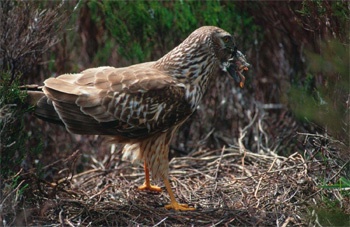As the grouse shooting season gets under way, two scientists involved in high-profile studies of hen harriers and red grouse at Langholm Moor in Scotland have called for field trials of a “ceiling” on harrier numbers in an attempt to end the long running conflict between conservationists and grouse managers.
In a new paper published in the British Ecological Society's Journal of Applied Ecology, Dr Simon Thirgood and Professor Steve Redpath from the Aberdeen Centre for Environmental Sustainability (ACES) - a joint initiative between the University of Aberdeen and the Macaulay Institute - suggest the most effective way of improving the conservation status of harriers on grouse moors might be to apply local "ceilings" to the number of breeding birds.
High densities of hen harriers are incompatible with driven grouse shooting and consequently, gamekeepers illegally kill these protected birds of prey. As a result, harriers are absent from large areas of apparently suitable moorland habitat.
According to Professor Redpath: "All moors can cope with some harriers, but few gamekeepers allow any of these predators to breed because of the fear that numbers will subsequently flourish. A ceiling scheme is a way of encouraging grouse managers to put an end to illegal killing of harriers, safe in the knowledge that numbers will not reach densities where they can threaten the viability of their grouse moors."
The authors propose a large-scale trial where a ceiling to harrier numbers on grouse moors could be agreed locally by interested parties, and that additional birds could then be safely moved to other areas.
"If successful, this could prove to be a way to both minimise the local impact of predation on grouse moors and increase the national population of harriers – providing a 'win-win' situation for harrier conservation and grouse management," Professor Redpath says.
Progress in reconciling the two camps had reached a stand-still with both sides distrusting each other, and a ceiling system is worth a "serious look" as an acceptable compromise, he adds.
According to Professor Redpath: "Hunters have been slow to recognise that illegal killing of raptors is unacceptable in 21st Century society where there is strong support for conservation. Conservationists, on the other hand, have been unwilling to compromise over any form of intervention to limit harrier densities, citing European legislation which prevents such action."
"We feel that a fundamental change in attitude is required from all parties to resolve the conflict between harriers and grouse. If those involved genuinely wish to strive for a solution then compromises will be required and attitudes to predators, their control, and their protection, will have to be modified to accommodate changed circumstances," he says.
Last September, a £3m follow up to the Langholm project was launched by a partnership of organisations including Scottish Natural Heritage, RSPB, the Game & Wildlife Conservation Trust, Natural England and Buccleuch Estates. The ten year project focuses on the use of "diversionary feeding" – providing alternative food for the harriers to reduce their predation on grouse chicks.
But Professor Redpath says questions remain about the effectiveness of this approach: "Our earlier work showed that feeding harriers can greatly reduce predation rates on grouse chicks. However, we still do not know how feeding will affect harrier numbers in the long term and indeed whether fed harriers and grouse shooting can coexist."
"Some of these issues will be addressed by ongoing work at Langholm. However, we suggest that the quickest way of finding an effective solution to this problem is to simultaneously make progress on different fronts – it is sensible to test a 'harrier ceiling' now, and not wait for ten years until the Langholm Moor Demonstration Project is complete," Professor Redpath concludes.
Simon Thirgood and Steve Redpath (2008). Hen harriers and red grouse: science, politics and human-wildlife conflict. Journal of Applied Ecology, is published online on 12 August 2008.


